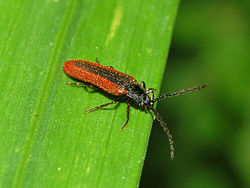| Omalisinae | |
|---|---|
 | |
| Omalisus fontisbellaquaei | |
| Scientific classification | |
| Domain: | Eukaryota |
| Kingdom: | Animalia |
| Phylum: | Arthropoda |
| Class: | Insecta |
| Order: | Coleoptera |
| Suborder: | Polyphaga |
| Infraorder: | Elateriformia |
| Family: | Elateridae |
| Subfamily: | Omalisinae Lacordaire, 1857 |
The Omalisinae (formerly family Omalisidae) [1] are a small subfamily of morphologically derived elaterid beetles. The Omalisinae were long considered an independent family in the deprecated family Cantharoidea (more closely related to soft-bodied beetles like fireflies, than click beetles), and later a family in the Elateroidea, but molecular phylogenies have demonstrated the morphological similarity of Omalisinae to other soft bodied beetles is a case of parallel evolution (homoplasy) of their soft bodies, rather than an apomorphy. Members of this beetle subfamily have been reported to have bioluminescent organs on the larvae, [2] although no recent publications have confirmed this. Some recent evidence indicated they were the sister group to a clade comprising the families Rhagophthalmidae and Phengodidae (glowworm beetles), [3] however a more comprehensive phylogenetic analysis based on genome sequences strongly supported the Omalisinae as being contained within the Elateridae. [1]